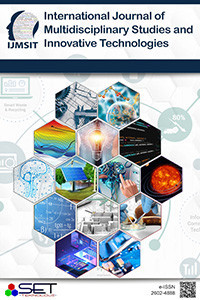FLOOD FORECASTING USING NEURAL NETWORK: APPLYING THE LSTM NETWORK IN THE MOSUL REGION. IRAQ
FLOOD FORECASTING USING NEURAL NETWORK: APPLYING THE LSTM NETWORK IN THE MOSUL REGION. IRAQ
Artifical, Neural Network, Long-Short-Term-Memory Forcasting, Floods,
___
- [1] S. Mei, A. Montanari, and P.-M. Nguyen, “A mean field view of the landscape of two-layer neural networks,” Proc. Natl. Acad. Sci. U. S. A., vol. 115, no. 33, pp. E7665–E7671, 2018.
- [2] V. Gulshan et al., “Development and validation of a deep learning algorithm for detection of diabetic retinopathy in retinal fundus photographs,” JAMA, vol. 316, no. 22, p. 2402, 2016.
- [3] Y. Liu, S. Liu, Y. Wang, F. Lombardi, and J. Han, “A survey of stochastic computing neural networks for machine learning applications,” IEEE Trans. Neural Netw. Learn. Syst., vol. 32, no. 7, pp. 2809–2824, 2021.
- [4] J. Bayer, D. Wierstra, J. Togelius, and J. Schmidhuber, “Evolving memory cell structures for sequence learning,” in Artificial Neural Networks – ICANN 2009, Berlin, Heidelberg: Springer Berlin Heidelberg, 2009, pp. 755–764.
- [5] G. Bellec, D. Salaj, A. Subramoney, R. Legenstein, and W. Maass, : “Long short- term memory and learning-to-learn in networks of spiking neurons,” 2018, pp. 787–797.
- [6] H. Gao, J. Mao, J. Zhou, Z. Huang, L. Wang, and W. Xu, : “Are you talking to a machine? dataset and methods for multilingual image question,” 2015, pp. 2296–2304.
- [7] J. Gong, X. Chen, T. Gui, and X. Qiu, : “Switch-lstms for multi-criteria chinese word segmentation,” 2019, vol. 33, pp. 6457–6464.
- [8] K. Greff, R. K. Srivastava, J. Koutnik, B. R. Steunebrink, and J. Schmidhuber, “LSTM: A search space odyssey,” IEEE Trans. Neural Netw. Learn. Syst., vol. 28, no. 10, pp. 2222–2232, 2017.
- [9] C. R., K. K. R., and D. E. Newton, “Drthis: Deep ransomware threat hunting and intelligence system at the fog layer,” Future Generation Computer Sys- tems, vol. 90, pp. 94 – 104, 2019.
- [10] T. Horsmann and T. Zesch: “Do lstms really work so well for pos tagging? – a replication study,” 2017, pp. 727–736.
- [11] Cho, K.; van Merrienboer, B.; Gülçehre, Ç.; Bougares, F.; Schwenk, H.; Bengio, Y. Learning phrase representations using RNN encoder-decoder for statistical machine translation. arXiv 2014, arXiv:1406.1078.
- ISSN: 2602-4888
- Yayın Aralığı: Yılda 2 Sayı
- Başlangıç: 2017
- Yayıncı: SET Teknoloji
Comparison of MOEA/D Variants on Benchmark Problems
Explication of the Remote Education Through Department Statistics: ESOGU-CENG Case Study
Merve CEYHAN, Yusuf KARTAL, Sinem BOZKURT KESER, Savaş OKYAY, Nihat ADAR
Efficient Hardware Optimization for CNN
Seda GÜZEL AYDIN, Hasan Şakir BİLGE
Roblox Studio İle Mühendislik Eğitimi İçin Deneyim Geliştirme
Sentiment Analysis Of Tweets Using Natural Language Processing
Nesnelerin İnterneti Cihazlarına Karşı Yapılan Makine Öğrenmesi Saldırıları
Author Identification with Machine Learning Algorithms
İbrahim YÜLÜCE, Feriştah DALKILIÇ
A Novel Student Performance Evaluation Model Based on Fuzzy Logic for Distance Learning
Beyza ESİN ÖZSEVEN, Naim CAGMAN
Gürsel KANSUN, Ahmad Omid AFZALI
FLOOD FORECASTING USING NEURAL NETWORK: APPLYING THE LSTM NETWORK IN THE MOSUL REGION. IRAQ
